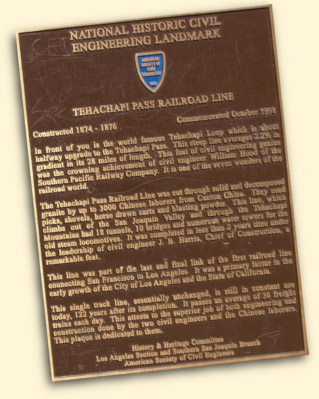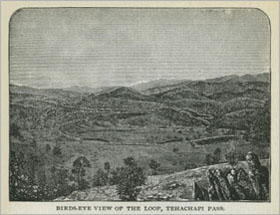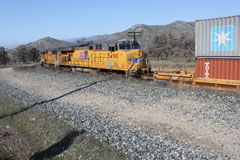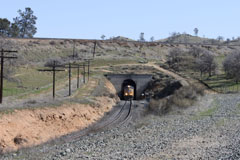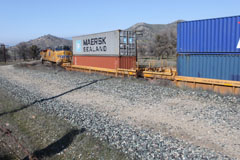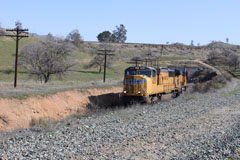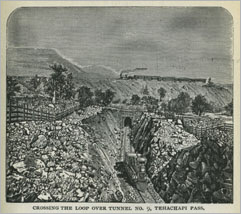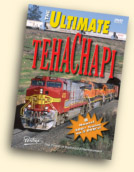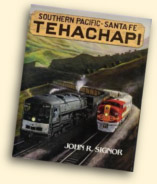Tehachapi Loop is at Walong, CA. Named after W. A. Long, a Southern Pacific District Roadmaster, there is really nothing here except a cluster of farm buildings and the loop itself. Ten miles north west of the town of Tehachapi, it is easily reached from the Woodford-Tehachapi Road.
The loop was completed in 1876. Built largely by Chinese labourers, it was part of the line carrying the Southern Pacific railway down from the Mojave plateau to the San Joaquin Valley through a narrow spur of hills that connects the southern end of the Sierra Nevadas and the Tehachapi Mountains.
Today, it is part of the Union Pacific system, although the BNSF also has trackage rights.
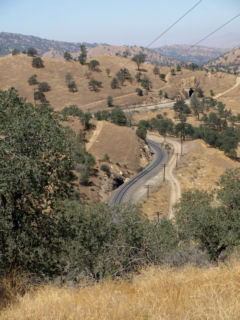
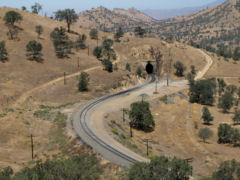
There are views of the line from Woodford-Tehachapi Rd as you near the loop from the south. The tunnels were numbered sequentially heading west from Bakersfield. Above is tunnel #10.
About eight miles north west of the loop at Caliente, the line passes through a horseshoe turn. You can see photos of it on the Caliente Horseshoe Curve page of this website.

Much of the loop is visible from an overlook a few yards off Woodford-Tehachapi Road although, in summer, tree foliage partly obscures much of the
view.
The panorama of the loop above, and the rugged country surrounding it, gives an idea of the challenges the railroad faced in carving a route through this part of California.
The loop was constructed under the supervision of William Hood, Southern Pacific's Engineer, and is one of only five railway loops in the US.
Because of its complexity, engineering a loop was generally a last resort for railroads, although they were built in quite a few countries where conditions demanded. Even with this solution, however, the average grade on the twenty-eight mile section through Tehachapi Pass is 2.2%.
"Birds Eye View of the loop, Tehachapi Pass" on the left is on page 239 of Crofutt's 1879 New Overland Tourist and Pacific Coast Guide.
Crofutt describes the loop as
"one of the greatest engineering feats in the world; feat where a railroad is like a good Roman Catholic–-made to cross itself" (page 240).
You can see Crofutt's 1879 New Overland Guide and download a word searchable PDF copy from the books and manuals page of this website.

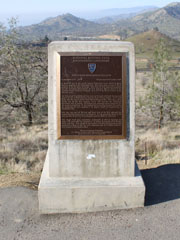
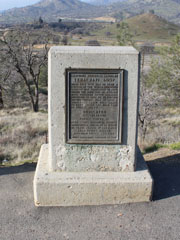
There are two commemorative markers at the overlook.
The first (on the right), a California Historical Landmark, was dedicated on 25th October 1953. It was placed by a number of local organisations, including the Kern County Historical Society, the Kern Museum and the Southern Pacific Railroad.
The second (on the left) was dedicated in October 1998 by the American Society of Civil Engineers and marks the loop as a National Historic Engineering Landmark. It recognises the achievements of the engineering staff and the c.3,000 Chinese labourers who built the line.
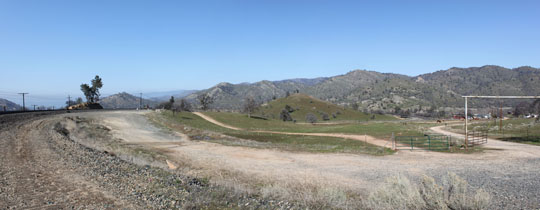
The white cross just visible at the top of the hill at the centre of the loop was erected in memory of two Southern Pacific employees killed in a derailment on the Palmdale-Colton Cut-Off at the foot of Cajon Pass near San Bernardino, CA. It is known as "The Cross at the Loop".
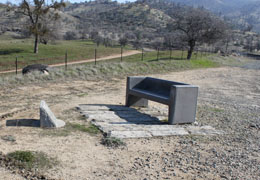
A few yards north of the Broome Road crossing near trackside is a commemoration of the "Cross at the Loop". It consists of a concrete seat resting on a bed of granite stones, facing a somewhat weathered granite marker.
All sixty-nine cars and six locomotives derailed when the train reached a curve next to Duffy St near Highland Ave. The runaway train reached speeds in excess of 90 mph before derailing.

The granite marker is set on a concrete base. It reads:
THE CROSS AT THE LOOP
IN MEMORY OF
CONDUCTOR EVERETT S. CROWN
BRAKEMAN ALLAN R. RIESS
WHO LOST THEIR LIVES IN A
TRAGIC TRAIN WRECK IN
SAN BERNADINO CALIF
MAY 12 1989
ERECTED BY
EMPLOYEES AND SPTCO
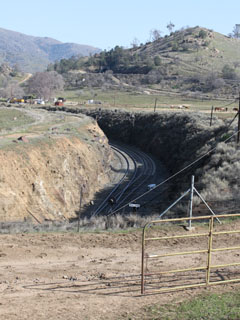
A little further, you can look down into the cutting where Walong siding terminates just before the line enters Tunnel #9. On the hill in the distance, the line emerges from Tunnel #10.
Below, a view east from the Broome Rd rail crossing.
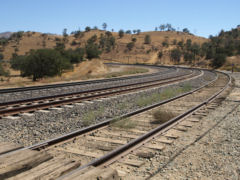
 Click here to see a full 360° swf panorama from this viewpoint.
Click here to see a full 360° swf panorama from this viewpoint.
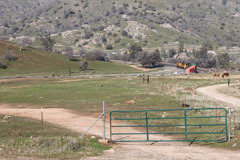

Above, a westbound double stack emerges from Tunnel #9 hauled by UP GE ES44AC #7412 and SD70Ace #8569.
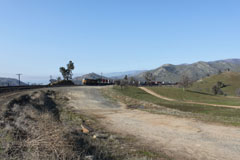
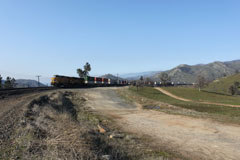

In the panorama above, the train approaches Broome Road crossing. It has climbed 77' from the exit of Tunnel #9.
Broome Road curves away on the far right in this view, and CA Highway 58 is visible just above the farm buildings. There is an exit to Broome Road on the eastbound lane of CA 58 only, but it is sometimes blocked by a locked gate, so it is better to approach the loop on the Woodford-Tehachapi Road.
A farm incorporates much of the land on which the loop is built, including the "Cross at the Loop". It is private land, fenced, and there are "No Trespassing" signs posted.

Above, the train passes over Broome Road crossing.

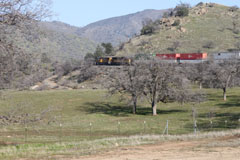
Above, the locomotives round the hill next to the Woodford-Tehachapi Road overlook.
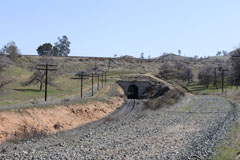
Above, Tunnel #9 from trackside near Woodford-Tehachapi Road.
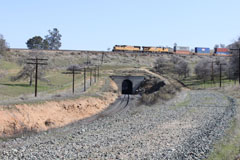
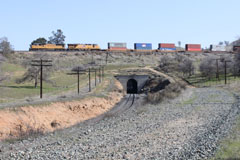
Above, UP EMD SD70M #4230 and GE AC45CCTE #5490 haul a double stack over Tunnel #9.
Roughly thirty-five trains traverse the loop each day, but there can be times when the traffic is quiet.
There are no amenities at Walong: the nearest are three miles away in Keene. The loop is about one hundred and twenty miles from Los Angeles, so you can make a day-trip from there. There are also hotels in the town of Tehachapi about eight miles south on CA 58, or at Bakersfield thirty-six miles west.
Above, UP #4230 and #5490 pass through Tunnel #9.
On the left, "Crossing the Loop over Tunnel No.9, Tehachapi Pass" is another illustration from page 233 of Crofutt's 1879 New Overland Tourist and Pacific Coast Guide.
You can see Crofutt's 1879 New Overland Guide and download a word searchable PDF copy from the books and manuals page of this website.

Just north of the loop on Woodford-Tehachapi Road there is a monument to the "Great Flood of 1932 and Engine No.3834". It was erected in 1993 by Peatrix Chapter No.2 & Peter Lebeck Chapter of the E Clampus Vitus organisation.
The inscription on the plaque reads:
On September 30th torrential rains flooded Tehachapi Creek, undermining the tracks under Santa Fe Engine No. 3834 which was waiting out the storm about ½ mile east of Woodward Station. The engine disappeared into the raging water below. It remained "lost" for two weeks, hidden under 10 feet of mud. It took one month to free the severely damaged engine. Its bell was never found. Almost three years after the flood the newly refurbished engine was returned to service with people lining the tracks in Tehachapi and Keene, waving and cheering as No. 3834 rolled by – its new bell proudly ringing.
The Ancient and Honorable Order of E Clampus Vitus is a fraternal organisation founded in the days of the California Gold Rush to spoof other orders such as the Masons, Elks and Lions. The name is actually Dog Latin, has no known meaning and its origins are unclear. Today, it specialises in placing commemorative plaques on sites often overlooked by more serious historical organisations, particularly those with a Western heritage or gold mining interest. Members call themselves "Clampers", and there are chapters in California, Nevada and other Western states.
You can see another E Clampus Vitus plaque on the Palisade page of this website.
